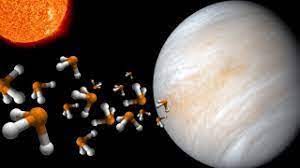Phosphine : At Deeper Level In Venus

Scientists have detected phosphine at deeper level in Venus’ atmosphere than before using the James Clark Maxwell Telescope (JCMT) at Mauna Kea Observatory, Hawaii.
- Phosphine on Earth is developed naturally by bacteria that live in very low-oxygen environments.
- To produce phosphine, Earth bacteria take up phosphate from minerals or biological material and add hydrogen.
- It is also called as hydrogen phosphide.
- It is a colourless, flammable, extremely toxic gas with a disagreeable garlic like odour.
- It is formed by the action of a strong base or hot water on white phosphorus or by the reaction of water with calcium phosphide (Ca3P2).
- It is structurally similar to ammonia(NH3), but phosphine is a much poorer solvent than ammonia and is much less soluble in water.
- Phosphine is used in semiconductor and plastics industries, in the production of a flame retardant, and as a pesticide in stored grain.




